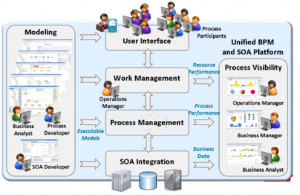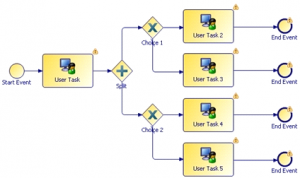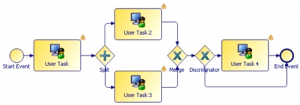TIBCO Business Process Management
What is Business Process Management – BPM ?
Here we go with the definition of BPM in relating to our lifestyle.
BPM can be defined as “workflow.” As an example, let’s consider a loan application or offer management in a bank.
A customer wants to apply for a product such as a debit or credit card, then he must follow the bank policies by signing an agreement.
The cards and offers can be categorized into various types based on the income of the customer. After completing the steps, it needs approval from the supervisor to proceed with next processes. This type of step by step process with human activities in conjunction with automation is called “Business Process.”
How TIBCO BPM Plays this Role in Real Life
TIBCO Business Process Management helps in the execution of various processes such as user interface , roles management and authentication as mentioned above. The diagram shows the integration of various parts such as models, workflow and processes.
For example: a user/customer can be given an application form to fill in with his personal details and salary. This form will determine if the customer is eligible by inquiring the bank’s database for his/her provided information.
What are the Features of TIBCO Business Process Management and How is it Different from other Tools?
From the developers point of view:
TIBCO AMX BPM can be used for the following:
- It provides end to end visibility into the business processes and also manages the work , process and resource.
- Multiple applications can be handled.
How Can We Implement TIBCO BPM in Business Studio?
Steps to construct:
We can create a project for BPM by selecting the BPM as the destination environment. Choosing BPM as the destination environment enables TIBCO Business Studio to utilize special features. For example, for processes, TIBCO Business Studio performs validation according to the selected destination environments. Other artifacts (for example, organization models) are not affected by project destination settings.
You can refer the TIBCO business Studio BPM Edition for more details.
TIBCO BPM uses drag and drop.
Here are some steps:
- Create a task after the “start” by dragging and dropping
- Set the path and priority
- Set the Condition (Decision) with the JavaScript .
It appears as below:
Application:
How Do We Implement TIBCO BPM in a Real Life Scenario?
Let’s assume few scenarios ,
- A customer (user) wants to transfer his money via MoneyGram from the US to India. Doing this requires background verification, or “screening.” The customer would have been reviewed by a human who would have uploaded the information into the system prior to the transaction.
- A prospect of a Bank wants to become a customer
- Someone wants to get a broadband or DTH connection from the service providers
For the above scenarios, the customer’s application can be approved or rejected based on the authority’s decision. Hence we keep the path with the condition and process the next step.
In TIBCO BPM we have activities/palettes to operate based on the requirements. Here are some common methods where we can model the tasks based on the scenarios.
- Exclusive Choice
- Simple Merge
“Exclusive Choice” is a common method used to diverge from a single Activity.
The below diagram shows the appearance of the Exclusive Choice method
Simple Merge:
This is ideally to merge the convergence of all the exclusive choices to single activity. This is also called as XOR joins.
Appears as below
Exclusive Choice and Merge:
References:
https://docs.tibco.com/products/tibco-activematrix-bpm-4-0-0




